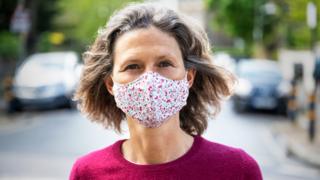What are the rules for masks in schools?

Secondary pupils in local lockdown areas of England will have to wear face coverings in school corridors from the beginning of September.
In addition, face coverings can be introduced in any secondary school if the head teacher decides to do so.
What are the face covering rules in schools?
In England, secondary schools will have the ”discretion” to require face coverings in communal areas, where social distancing is not possible.
However, they will be mandatory for schools in parts of England that are under a local lockdown or facing extra government restrictions.
These areas currently include:
- Blackburn with Darwen
- City of Manchester
- Leicester
- Luton
- Oldham
- Pendle
- Northampton
This will not include in classrooms during lessons, where the government says they could “inhibit learning”.
The new guidance extends to further education colleges but not to primary schools.
Secondary school pupils in Scotland and Northern Ireland have to wear face coverings between lessons from 31 August.
The Scottish government says all pupils over the age of 12 should wear face coverings in corridors and communal areas, but will not have to wear them in classrooms.
On school buses, everyone over the age of five will have to wear face coverings.
The advice is similar in Northern Ireland, where the Education Minister said guidance on face coverings would be updated to include wearing them in the corridors of post-primary schools.
In Wales, it will be up to schools and councils to decide if face coverings are used. But the government is recommending those aged 11 and over wear them when social distancing cannot be maintained, including in schools and school transport.
It will require local authorities to do risk assessments to determine this.
What about in shops?
Face coverings must be worn in shops, supermarkets and shopping centres in England, Scotland and Northern Ireland – but not Wales.
Those who fail to do so can be fined by the police – up to £100 in England, or £60 in Scotland and Northern Ireland.
Shop workers do not have to wear face coverings.
How about other indoor spaces?
In England and Scotland, face coverings are also compulsory in a number of indoor spaces. These include:
- Banks, building societies and post offices
- Places of worship
- Museums, galleries and entertainment venues
- Libraries and public reading rooms
Face coverings do not have to be worn where it would be ”impractical” to do so – for instance, restaurants, pubs and gyms.
In Northern Ireland, apart from shops, the rule includes “any other indoor place where goods or services are available to buy or rent… for example, a bookmakers, a food takeaway business or a dry cleaner”.
In Wales you are not currently compelled to wear a face covering in shops.
Who doesn’t have to wear a face covering?
Some people do not have to wear a face covering. They include:
- Children under 11
- Those unable to put on or wear a face covering because of a physical or mental illness or disability
- People for whom wearing or removing a face covering will cause severe distress
- Anyone assisting someone who relies on lip reading to communicate
You can take off your mask if:
- You need to eat, drink, or take medication
- A police officer or other official asks you to or if shop staff need to verify your age
- You are entering a shop to avoid harm, if you do not have a mask on you
Young children should not wear face masks because of the risk of choking and suffocation.
What are the face covering rules on public transport?
Face coverings are compulsory for anyone travelling by public transport in England, Scotland, Wales and Northern Ireland (unless they have an exemption or a reasonable excuse).
Passengers boarding aircraft in England, Scotland and Wales must wear a face covering – Northern Ireland also recommends their use.
People can be refused travel if they do not follow the rules, and can be fined as a last resort.
Where am I supposed to get a face covering?
The government has been careful to use the term “face covering” rather than “face mask” – with surgical masks kept for medical use.
The BBC has created a guide on how to make your own face covering. The government has issued its own advice too.
Do face coverings work?
World Health Organization (WHO) advice says non-medical face coverings should be worn in public where social distancing is not possible.
Coronavirus is spread when droplets are sprayed into the air when infected people talk, cough or sneeze. Those droplets can then fall on surfaces.
The WHO says there is also emerging evidence of airborne transmission of the virus, with tiny particles hanging in aerosol form in the air.
Homemade cloth face-coverings can help reduce the spread from people who are contagious but have no symptoms or are yet to develop symptoms.
Scientists in Singapore suggest the contagion risk is especially high in the 24-48 hours before an infected person is even aware they might have the disease.
Taking a face covering on and off can also risk contamination, the WHO says.
What do I need to know about the coronavirus?
- A SIMPLE GUIDE: How do I protect myself?
- AVOIDING CONTACT: The rules on self-isolation and exercise
- HOPE AND LOSS: Your coronavirus stories
- LOOK-UP TOOL: Check cases in your area
- VIDEO: The 20-second hand wash
- Personal protective equipment (PPE)
- Retailing
- Coronavirus lockdown measures
- Viruses
- Coronavirus pandemic
- Social distancing
Source: Read Full Article
